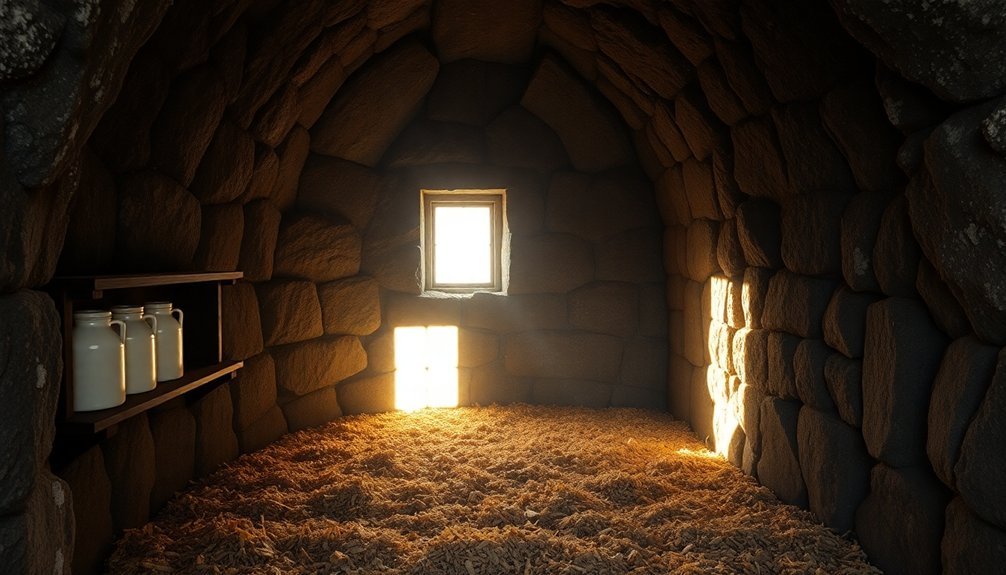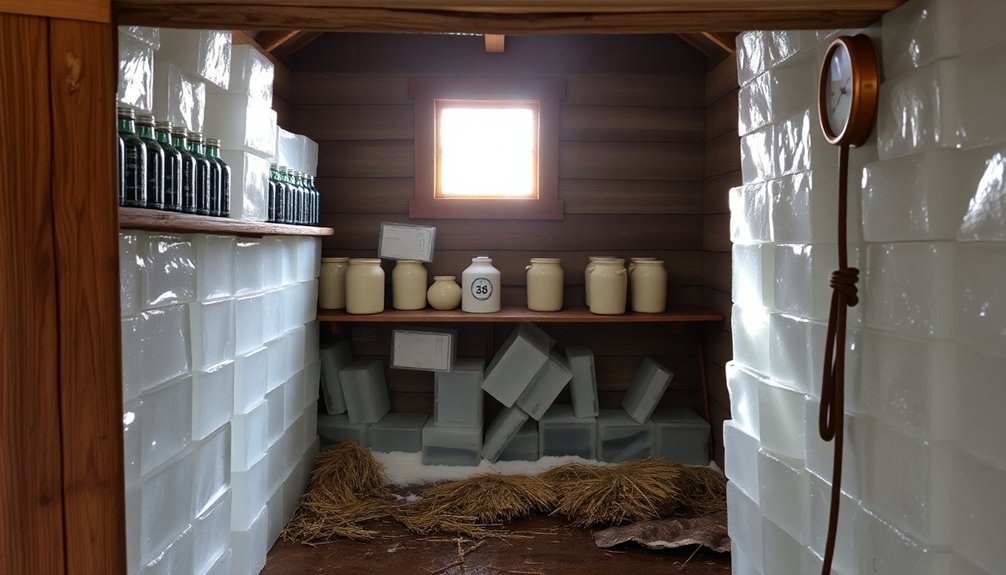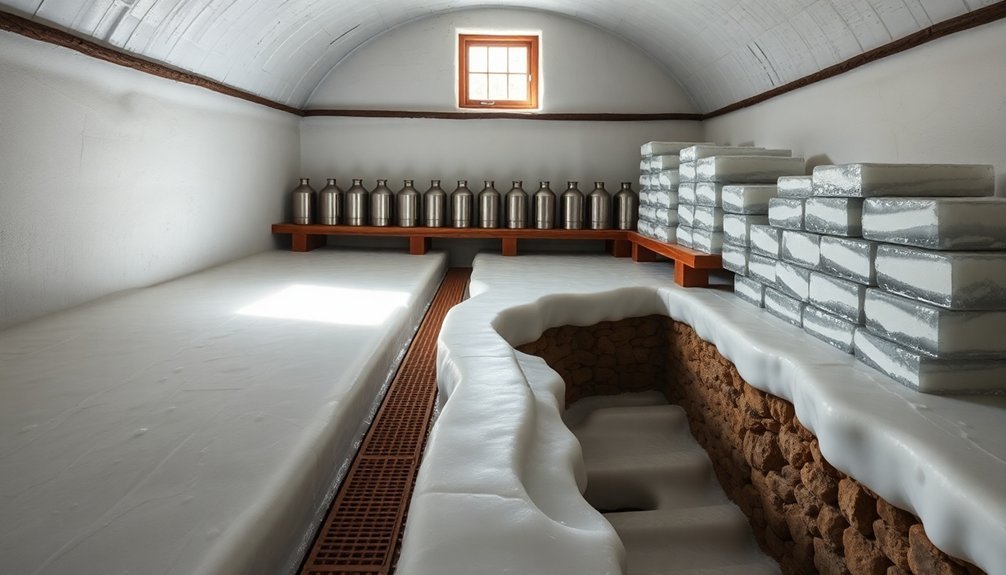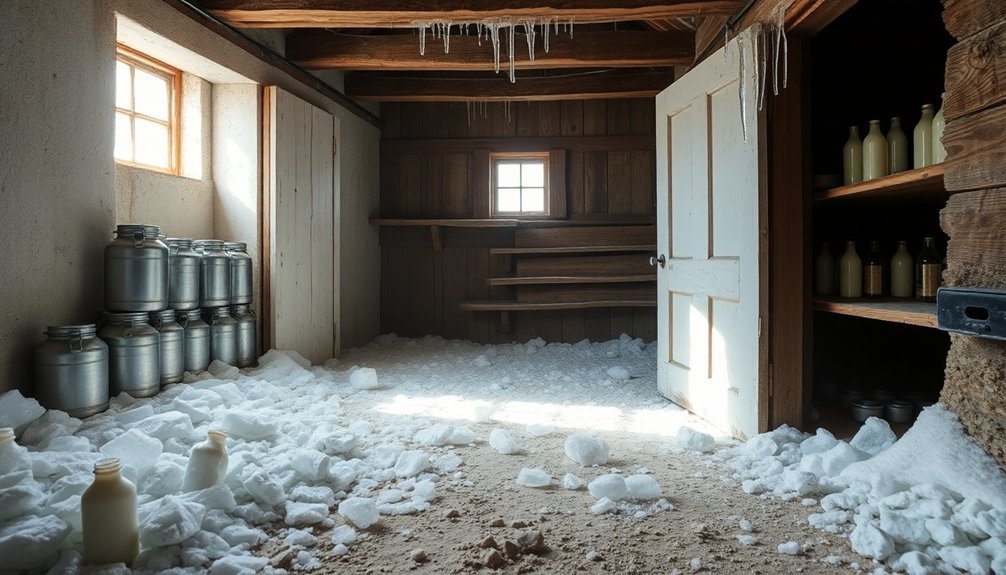Ice houses protect your farm-fresh dairy through five key design elements. You'll benefit from thick walls that provide natural insulation against extreme temperatures while reducing energy costs. Strategic airflow systems with properly placed fans and filters guarantee consistent temperature distribution throughout the space. Layered ice storage methods using insulating barriers like sawdust maintain ideal temperatures around -8°C. Smart location planning takes advantage of natural shade and well-draining soil. Innovative drainage systems prevent moisture issues and manage temperature fluctuations. These integrated elements form a thorough approach to dairy preservation that's worth exploring in depth.
Temperature Control Through Thick Walls

You're also getting protection from external factors that could spike temperatures inside.
The walls shield your storage space from direct sunlight, wind, and extreme weather conditions.
This means you'll save on energy costs while maintaining ideal storage conditions, as the walls' natural properties reduce the need for active cooling systems.
Maintaining consistent temperatures throughout storage is essential for optimal dairy safety.
It's an efficient, sustainable approach to keeping your dairy products fresh and safe.
Strategic Airflow Design
While maintaining proper temperature is essential, an effective ice house requires careful attention to airflow design for optimal dairy storage.
You'll need properly placed terminal devices and carefully managed air distribution systems to prevent condensation and maintain consistent conditions throughout your storage space. Building Management Systems help automate and enhance maintenance efficiency. By implementing large diameter, low-speed fans, you'll create column-shaped air jets that effectively displace stagnant air and establish reliable circulation patterns.
Strategic airflow design in your ice house should focus on these key elements:
- Terminal velocities must stay within 100-150 FPM for spaces below 65°F, guaranteeing proper air movement without causing temperature fluctuations.
- Double deflection diffusers and register grills help prevent condensation while maintaining comfort and optimal air distribution.
- Pressure sensors and controls work together to maintain ideal pressure relationships, preventing unfiltered air from entering critical storage areas.
- High-performance filtration systems, including MERV 7 prefilters and MERV 15 final filters, guarantee clean air circulation throughout your facility.
Layered Ice Storage Methods

Efficiency in ice storage relies heavily on proper layering techniques within your dairy facility's ice house. You'll need to carefully stack ice cakes and implement insulating barriers between layers to maintain ideal temperatures around -8°C. Using materials like sawdust, shavings, or fodder between layers creates essential protection from external heat.
| Layer Type | Purpose | Key Benefits |
|---|---|---|
| Base Layer | Drainage & Foundation | Prevents melting from ground contact |
| Ice Block Layer | Core Storage | Maintains consistent temperature |
| Insulation Layer | Heat Protection | Extends ice preservation time |
You can enhance your layered storage by incorporating elevated water tanks and perforated pipes for supplemental ice production during cold weather. This combination of natural and artificial ice creation helps you maintain steady supplies throughout peak demand periods. When you're setting up your storage system, guarantee proper circulation by using forced air and compressed air distribution methods. For modern operations, you'll find that stainless steel ice bank silos offer superior storage capabilities, allowing you to produce ice water at 0.5°C while taking advantage of cost-effective night-time electricity rates for production. The falling film chillers provide additional cooling efficiency when integrated with your layered ice storage system.
Smart Location Planning
Selecting an ideal location for your ice house stands as a vital first step in dairy operations. You'll want to focus on spots that naturally maintain cooler temperatures and offer protection from direct sunlight. Shaded areas beneath evergreen trees provide ideal year-round coverage, while north-facing positions help minimize sun exposure through your ice house's entrance.
The ground beneath your ice house plays a significant role in its effectiveness. You'll need well-draining soil, preferably sandy or gravelly, to prevent unwanted moisture from compromising your ice storage. Avoid clayey or rocky areas that could retain water and accelerate ice melting.
- Position your ice house on elevated ground to create natural air insulation.
- Build near a reliable water source for convenient ice harvesting.
- Utilize natural earth banks when possible to enhance insulation.
- Guarantee adequate distance from heat-generating farm structures.
When you're integrating your ice house with the landscape, you'll need to take into account how local climate patterns affect your specific site.
Build double-walled partitions filled with insulating materials like sawdust, and incorporate roof ventilators to maintain proper air circulation while preventing warm air infiltration.
Drainage System Innovation

Modern drainage systems serve as the lifeline of any ice house dairy operation. You'll need temperature-resistant drains that can handle both pasteurization heat up to 161°F and freezing conditions. The system's backbone relies on stainless steel components, strategically placed point drains, and innovative slot drain technology that prevents ice blockages.
To maintain food safety and operational efficiency, you'll want to focus on preventing standing water and guaranteeing continuous flow. Pre-sloped designs and cleaning paddles make maintenance straightforward while reducing bacterial growth risks.
| Feature | Benefit |
|---|---|
| Stainless Steel Construction | Resists corrosion, chemicals, and temperature extremes |
| Slot Drain Systems | Eliminates ice blockages and simplifies cleaning |
| Pre-Sloped Design | Guarantees consistent water flow and prevents pooling |
When you're setting up your ice house drainage, remember that proper sizing is vital. Calculate your maximum liquid waste volume and design accordingly. Your system must comply with federal regulations while maintaining safe working conditions. By implementing these drainage innovations, you'll reduce maintenance costs, prevent water damage, and guarantee your ice house operates efficiently year-round.
Frequently Asked Questions
How Long Does It Take to Build a Traditional Ice House?
You'll need about 2-4 weeks to build a traditional ice house, depending on your construction experience, weather conditions, and design complexity. The foundation alone can take 3-5 days to properly set.
Can Ice Houses Be Used to Store Other Perishables Besides Dairy?
Yes, you can store various perishables in ice houses! They're perfect for meats, seafood, fruits, vegetables, and beverages. The cold temperatures and insulation help keep your food fresh for extended periods throughout the year.
What Is the Average Cost to Maintain an Ice House Annually?
You'll spend around $3,500-5,000 annually to maintain an ice house, including utility costs, repairs, regular cleanings, and water usage. Don't forget to factor in periodic equipment maintenance and potential emergency repairs.
How Many Ice Blocks Are Typically Needed for a Standard-Sized Ice House?
You'll need approximately 400-600 ice blocks for a standard ice house. Each block typically weighs 100-150 pounds, and you should plan to harvest enough to last through summer and fall months.
Do Modern Ice Houses Require Special Permits or Zoning Approvals?
You'll need to register your ice house if it's not removed daily. Display your permit number visibly on the structure, and keep a signed copy inside. Local regulations focus on safety rather than zoning.
In Summary
You'll find these five ice house features work together to protect your dairy products with remarkable efficiency. Whether you're focusing on the thick-walled construction, optimizing airflow patterns, storing ice strategically in layers, choosing the perfect location, or implementing innovative drainage, each element plays a vital role. By understanding and maintaining these key components, you're ensuring your farm's dairy stays fresh longer.





Leave a Reply